How does the Boat work?
Theories in Physics, The work Boats, How They Operate(How does the Boat work)And The Attached Physics:
Whenever you have seen a boat or ridden it, this thought must have always come to your mind that how does the boat work?The next time you look at a work boat, be it tug carrying cargo, ferry loaded with passengers or platform supply vessel (Biggest Type) they are managed to perform well under different circumstances by a beach mounted look at. If you take a closer look behind their innocuous looking design, you’ll realize they act according to quite intricate physics principles that dictate its movements and functions. Here we will discuss how work boats work and the hidden physics that underlies all this.

Introduction: How does the Boat work -
A work boat is a vessel designed for particular tasks like conveyance, maintenance, working and rescuing Generally compared to luxury yachts or recreational boats. There are many types of workboats ( tugboats, pilot boats, utility boats etc.)
The Elementary foundation of Boat Motion:
Newton’s Laws of Motion Workboats are operated according to a set of laws, and at the foundation of them all November 2017 are Newton’s Laws of Motion which describe motion in terms of how much force associated with the mass of the body. Laws of Here We Will Break these laws In Front of a work boat.
1st Law (Inertia):
This law refers to that a body which is at rest the mass remains at rest, and moves, moves until some external force acts on it. To a boat, that means that when it gets going it will keep going unless the water or other forces push against it Now you understanding how does the Boat work.
2. Second Law (Force and Acceleration):
The law says that F = ma(Force is mass times velocity F = ma). Thrust – The engines of a working boat causes the force to move the boat forward. The heavier the boat, the greater force is required to accelerate it.
3. Third Law (Action-Reaction):
As we know for every action there is an equal and opposite reaction.
REACTION:
Simply means that when the prop on a boat pushes water backwards, the other way it’s going to move is forward into boat.
That is the basic concept of how propellers work(How does the Boat work?).
Buoyancy:
That Force That Keeps Boats Afloat.
Archimedes buoyancy (a principle of boat handling) Now:
This is a fundamental concept of Archimedes’ principle buoyancy. Archimedes principle states that a body immersed in a fluid experiences an apparent loss in weight equal to the weight of fluid displaced. How does the Boat work? For workboats this means that the water displaced from its hull weighs as much as the boat for buoyancy and creates a net upwards force keeping the boat out of water.
And in this part, the hull design is one of the most important key for how does the Boat work. The hull needs to displace enough water for the boat to float on top, but not too much to generate drag that would serve as a bottle rocket.
In this case the hull design is key(how does the Boat work)design here. A properly designed hull moves water, but has the right amount of resistance that allows the boat to float the weight.

Thrust & Propulsion Systems:
Workboats have many different engines and propulsion systems to generate the thrust required for how does the Boat work?
Inboards Engines with Propellers:
The commonality among all work boats is an inboard motor with a prop, inboard meaning that it is located under the waterline in a sealed compartment.
The engine turns the propeller, which forces water backwards to propel the boat forward.
Jet Drives:
Jet Drives, used by some craft and particularly in shallow water
They draw in water and expel it high-speed, which generates the thrust.
Azimuth Thrusters; used in special purpose vessels to aid with the maximum capability of turning. They can turn 360 degrees, making the boat to move anywhere without changing its principal direction.
Hydrodynamics:
Water Flow with a Twist
Hydrodynamics examines how water travels around objects and it is essential to comprehend how work boats follow efficient manoeuvres. Various aspects such as drag, wake creation and wave drag impact a boats speed as well as its fuel consumption.
Drag:
As water passes a boat, it causes drag and some resistance. The harder the hull is able to conform, the less drag.
Wake Production:
Boat hulls displace water as they pass forcing waves or wakes. The hull type will be always determine only the size of this waves.
Forces due to Wave Resistance:
Waves greater than some minimum require you to expend more energy to go over them, thereby reducing fuel economy.
Examples of Physics at Work Boats in Real Life:
Tugboat and barge wiener. The barge has inertia (it wants to keep moving the same direction it is going now) and there is forth coming from water that needs fighting against to get some traction. Engineers use Newton’s second law calculate the thrust needed and account for buoyant forces of both vessels.

Workboats :
manoeuvring through the chop in offshore oil rig maintenance. Out at sea and in the water, it is hydrodynamic principles that help hulls meet waves with the least resistance, stability + safety.
Conclusion:
How does the Boat work? Work Boats are by far the best example of how physics performs its responsibilities. Everything from basic scientific concepts, such as Newton’s laws of motion to buoyancy and hydrodynamics influence every aspect in the design and functionality of a work boat. This not only shows us that all these engineering wonders is governed by the laws of physics but it shows us how blind we really are.
The next time your encounter a work boat slow down time and look at the perfect interplay between physics and technology that allow it to track through the water in such precision and might.

Pingback: Internet - Birth of Internet, ARPANET, World Wide Web
Pingback: how-does-a-washing-machine-clean-clothes? Are Washed in a
Pingback: History of Mughal Empire - nearlibrary.com